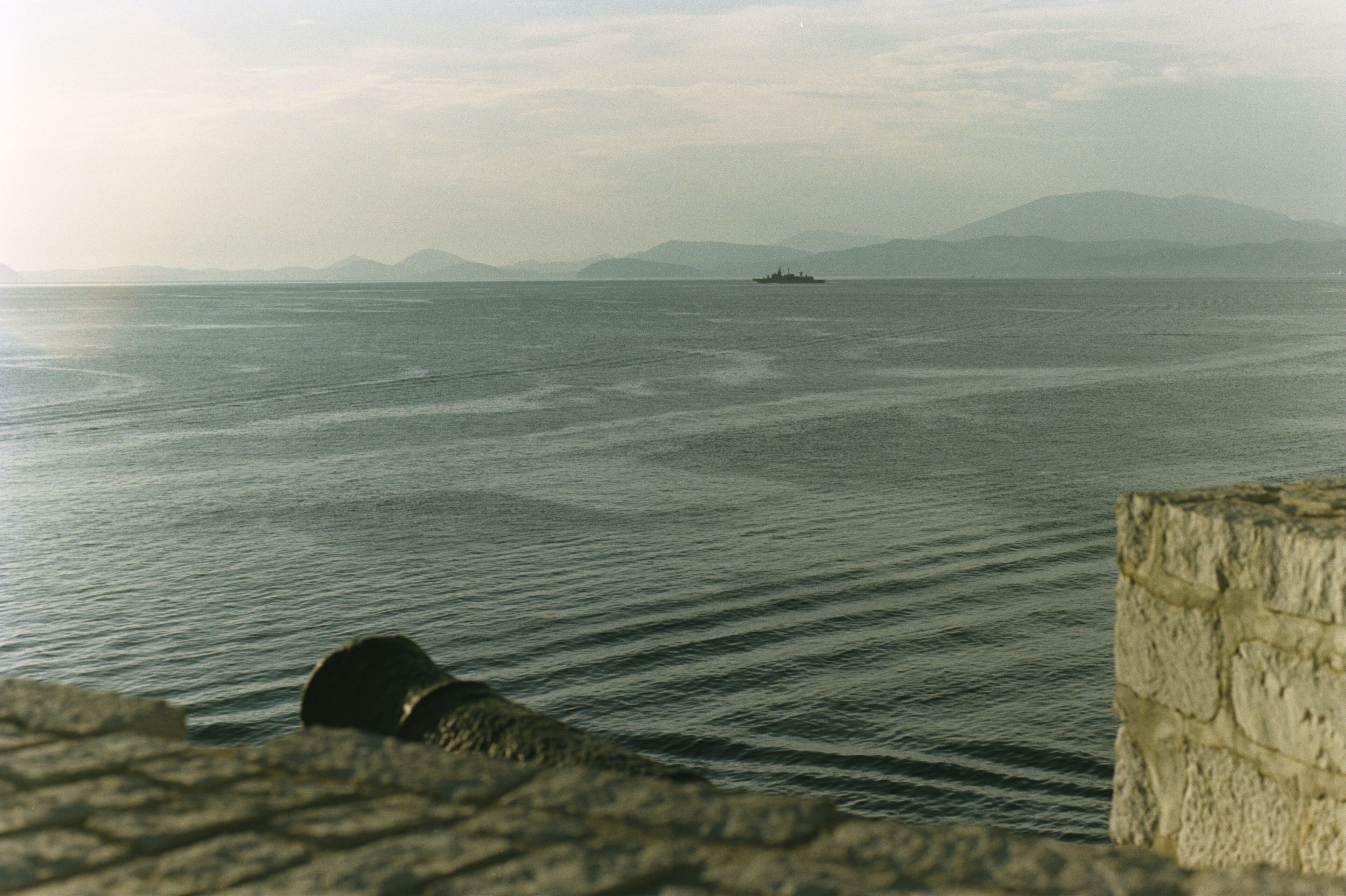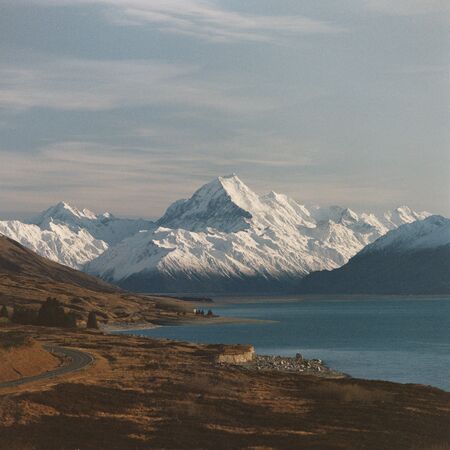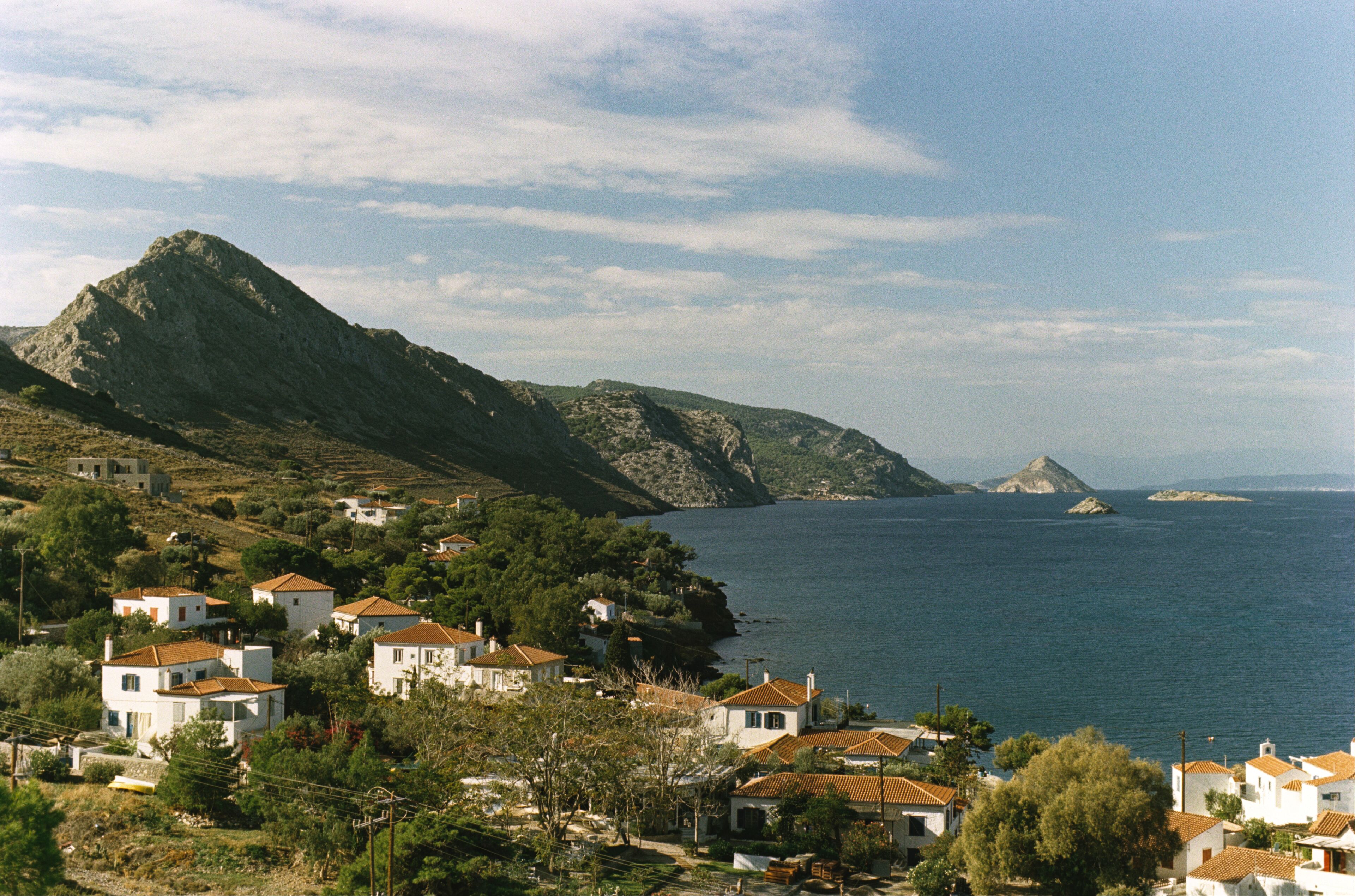
North coast
My recent travels around Egypt and Greece were inspired by Lawrence Durrell’s writing. He was a self-proclaimed islomaniac, someone that the “mere knowledge that they are on an island, a little world surrounded by the sea, fills them with an indescribable intoxication”. Durrell was a poet, novelist, and travel writer, and his work was particularly centered around the mediterranean and Greek Islands. Having decided on Greece as a destination, the next question was where to actually go. Athens was an easy one, and indeed standing at the Pynx where Pericles and Alcibiades once stood gave me shivers. Rhodes was drawn from Durrell’s book Reflections on a Marine Venus, and Hydra came from Leonard Cohen. In the infrequent sobriety of my twenties I read my way through Cohen’s poetry and novels. There I learned he spent time living on Hydra and the name of the island stayed in the back of my mind. While researching for this trip I saw Hydra on a map, gave it a once over, and decided to make it so.
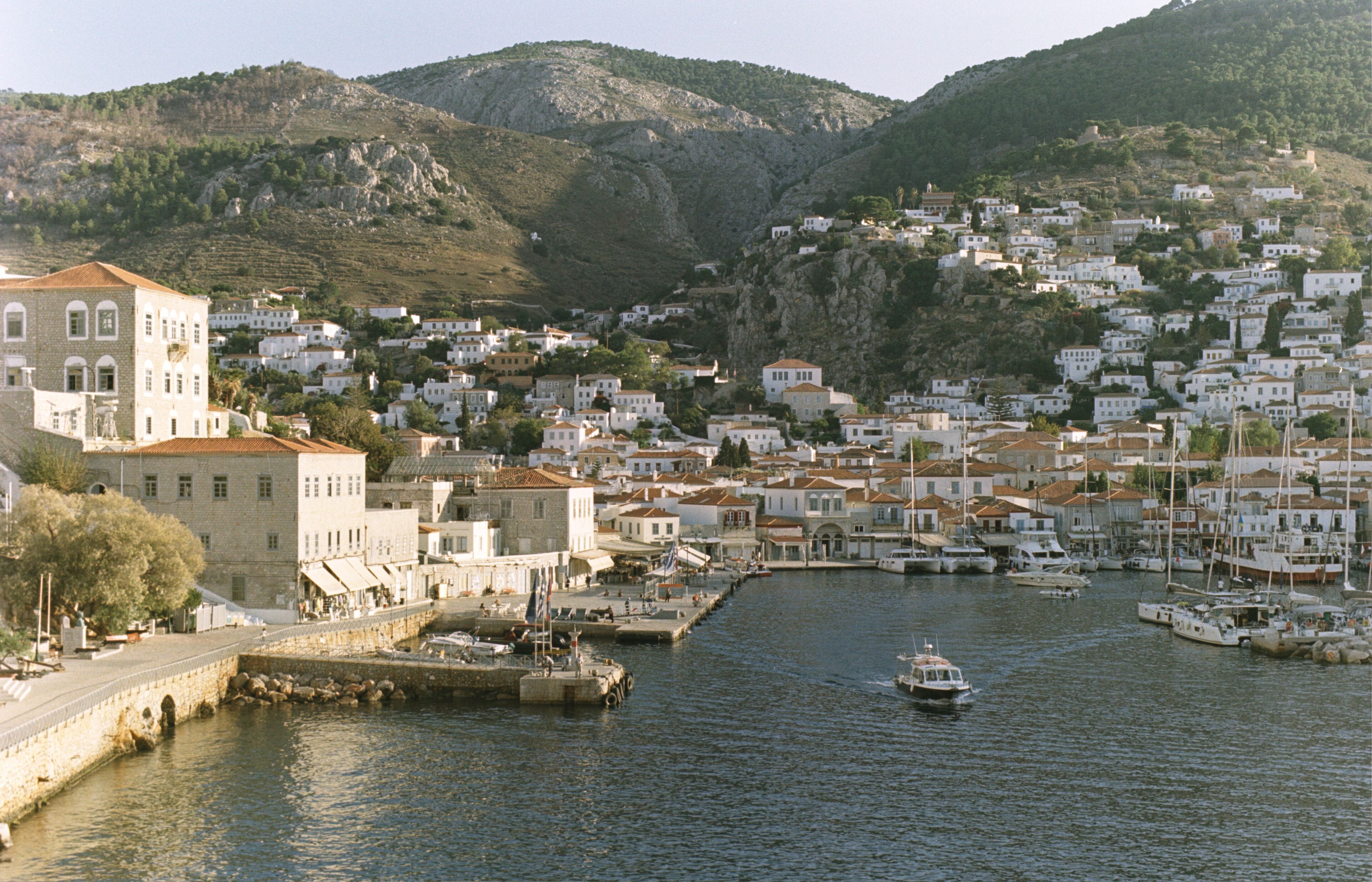
Hydra township
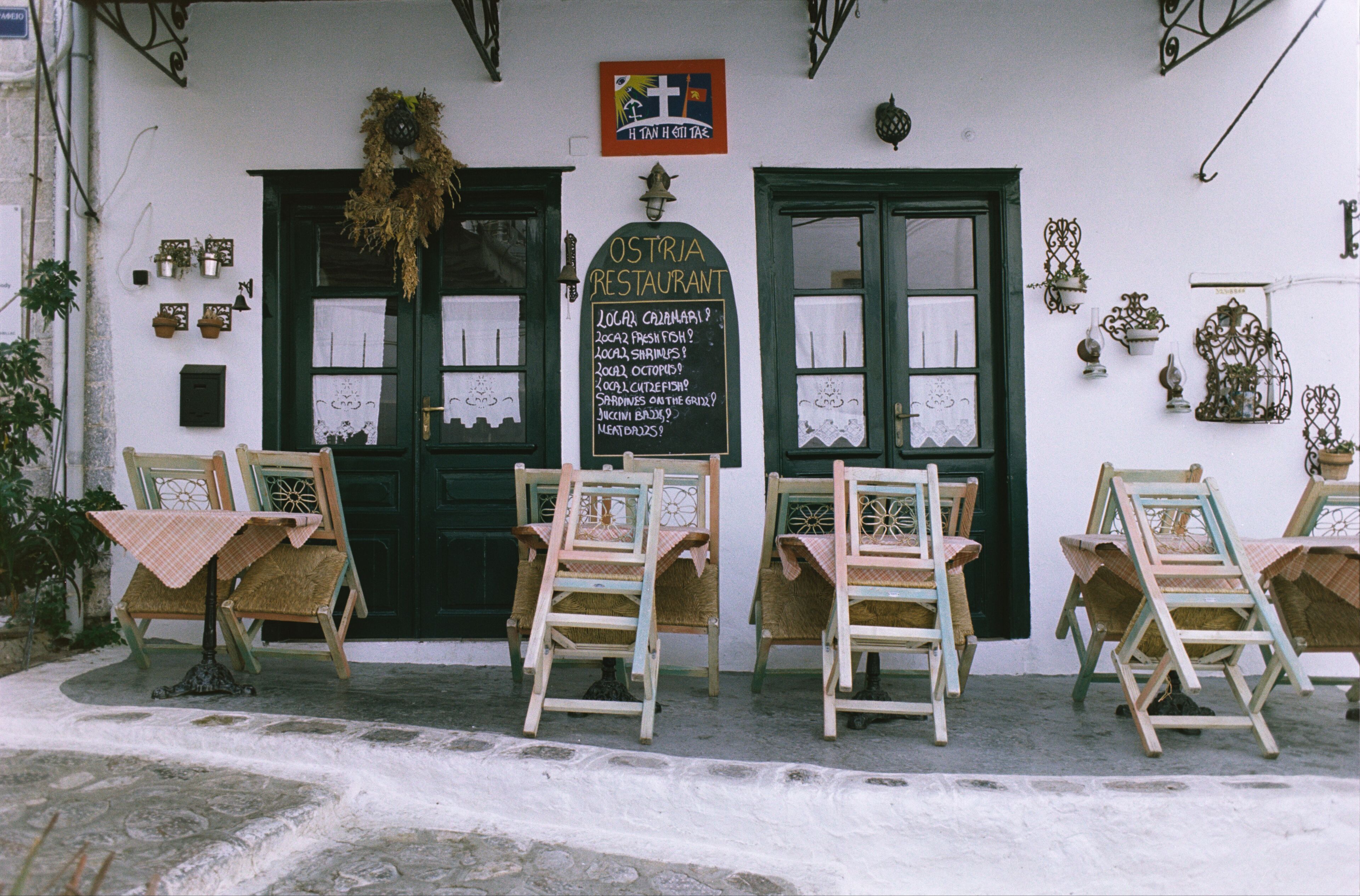
Kalimera
Lawrence Durrell published his first book in the nineteen thirties and over his nearly six decades of writing touched on many of the Greek Islands. Rhodes and Cyprus each have a booked devoted to them, recounting the time he spent living there. He describes Rhodes in its post-war state: poverty, barbed wire, and minefields, but with country side so alluring he’d set out for a day walk with a bottle of red and a light step. Durrell recalled how the locals resented the Italians (for they occupied Rhodes in WW2) but grudgingly gave them credit in two areas: first they weren’t as bad as the Germans, who showed up towards the end of the war and second, the Italians restored the Old Town and tried to preserve it from bombing and shelling. Much of Durrell’s poetry and novels describe aspects of the Greek Islands and the mediterranean. He also published the travelogue A Guide to the Greek Islands in which he devotes between a page and a chapter to different islands he visits. Durrell uses romantic language and describes locations in the manner of red wine, golden sunset, and your hand in that of a lover’s. My problem in having read all of these but never yet visited was that his descriptions of the Greek Islands all started blending into one. Reading these books in the wintery depths of Dunedin I’d formed the vision sort of a Median Greek Island – a blended vintage of sun, rock, beach, vine, olive, and spirit. Hydra, and not Rhodes, lived up to this vision.
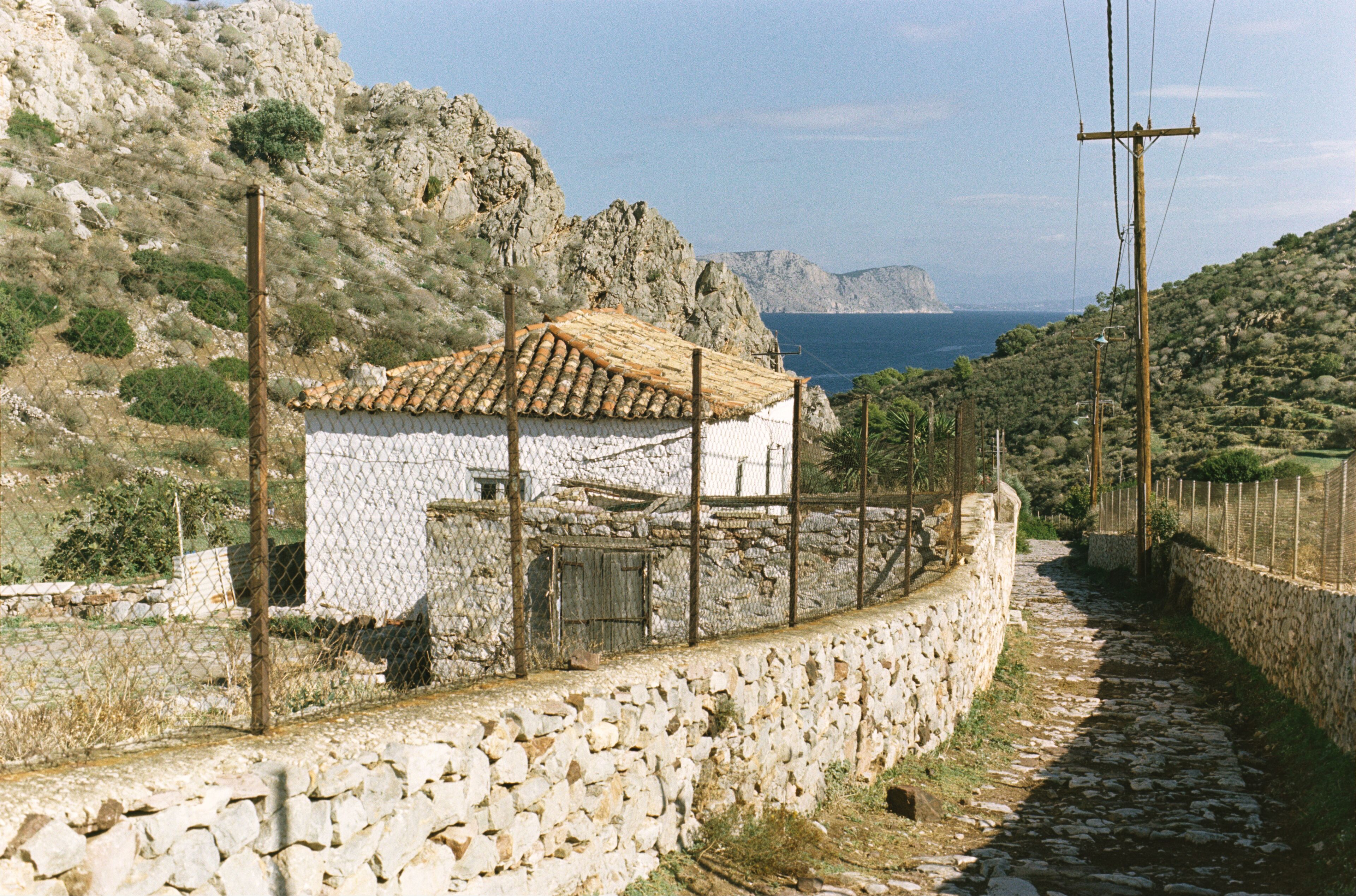
Inland from Vlychos
In A Guide to the Greek Islands Durrell describes Hydra as:
A barren rock, nude as a skull and waterless, it crouches in the austere splendour of its nudity, glowering at you. It is as silent and watchful as a Mycenaean lion – though perhaps that is not the right choice of image to convey its sphinxine immobility and sense of indestructibility. A battleship perhaps? A great horned toad? We should really ask the painter Ghika to choose a suitable image, for he is the real poet of the island and in his painting has gone as far as one man can to render Greek light and Greek stone. All the convolutions and curves of this labyrinth of walls and dazzling staircases coil and uncoil in his canvases, so that one finds oneself retracing the labyrinths of the inner ear as the eye slides down among the forms and drinks the bony colours of the glowing stone.
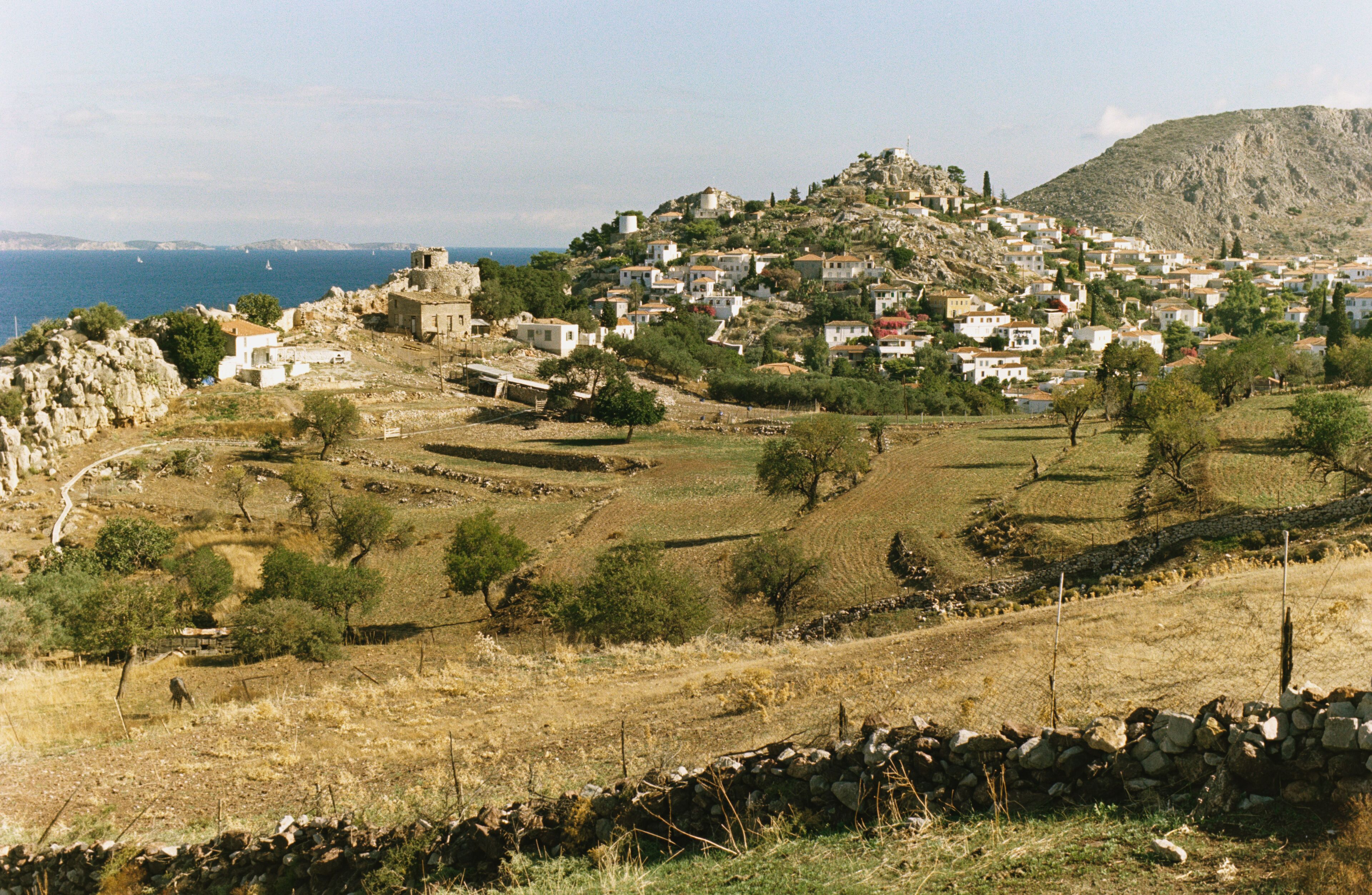
Shape of the landscape
The curse of books, whether seventy years or two and a half thousand years old, is that they portray a place as it was at the time. When we visit it is never the same. I had this experience in Egypt where my too idealistic a view was immediately shattered by the bullshit that hyper connectivity and modern conveniences bring. Why wouldn’t there be a group of teenagers recording a Tiktok dance in front of the Giza Sphinx? In this respect Hydra felt older and more disconnected. Paths in the village are steep, narrow, and twisting. Google Maps is refreshingly incomplete and unhelpful in navigating the paths which change direction whenever they feel like it. It’s a town of only two thousand people and it’s free of the generic fast food franchises and hotel chains. Wheeled vehicles aren’t allowed on Hydra. Instead, as you step off the boat you’re greeted by donkeys and horses ready to transport everything from a local’s new washing machine to the chicken you’re going to be eating a couple of hours later.
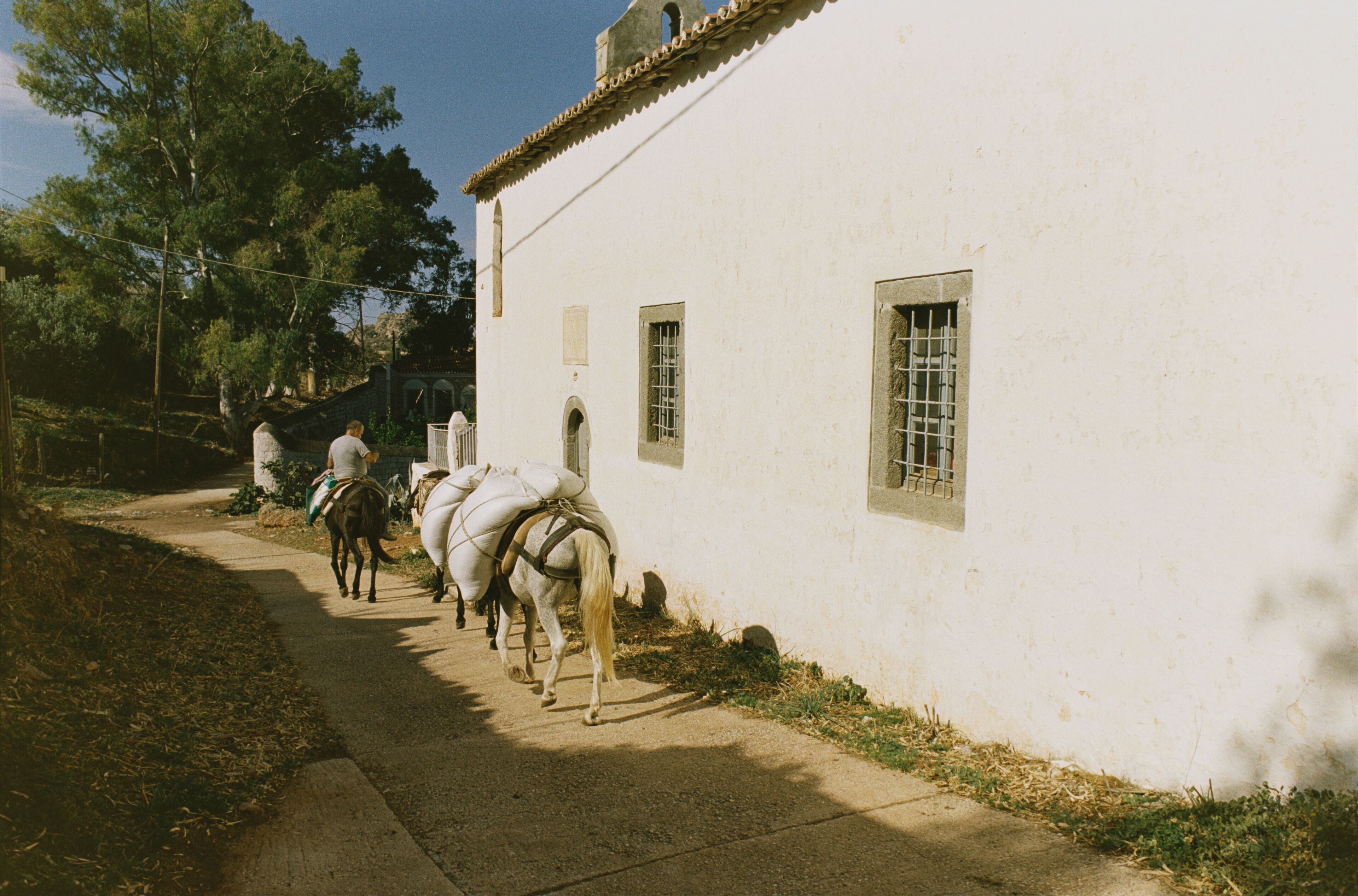
Feed
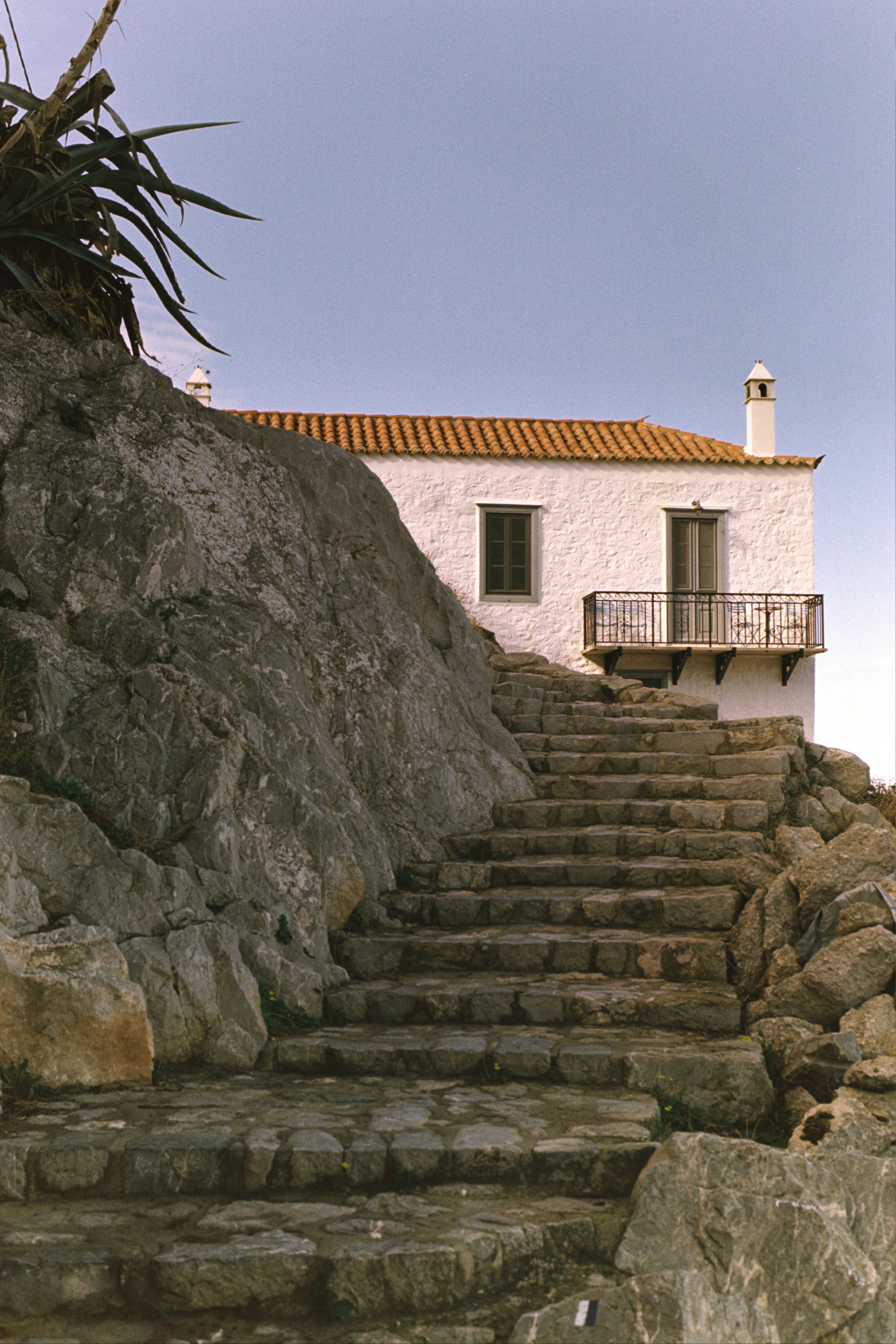
Pretty as a postcard
I brought the getting-slightly-less-trusty Olympus OM-1 film camera with 28mm, 50mm, and 100mm prime lenses. On six rolls of Porta 160 I surprised myself with a better than usual keeper rate. This trip has resulted in a large set of cohesive images. Usually when I shoot at a location, typically on digital, there are half a dozen or so keepers and the rest are average to ghastly. The photography gods blessed me, and while on Hydra I felt like I was taking good photographs and when I scanned the film I was relieved to see they were.
One of the things I like about shooting 35mm colour film is how I’m restricted in what I can edit in the digital darkroom. Compared to shots from my digital camera, I can only make minor adjustments to the white balance, colours, and exposure. This pushes me to think more in the field, compose better, and nail the details which results in a deeper in the moment photography experience and, hopefully, better photographs. Films have different colour characteristics and so one can get a new look by shooting on a different film stock. For this trip I was contemplating black and white film, but after seeing the results of Porta 160 I’m a happy camper.
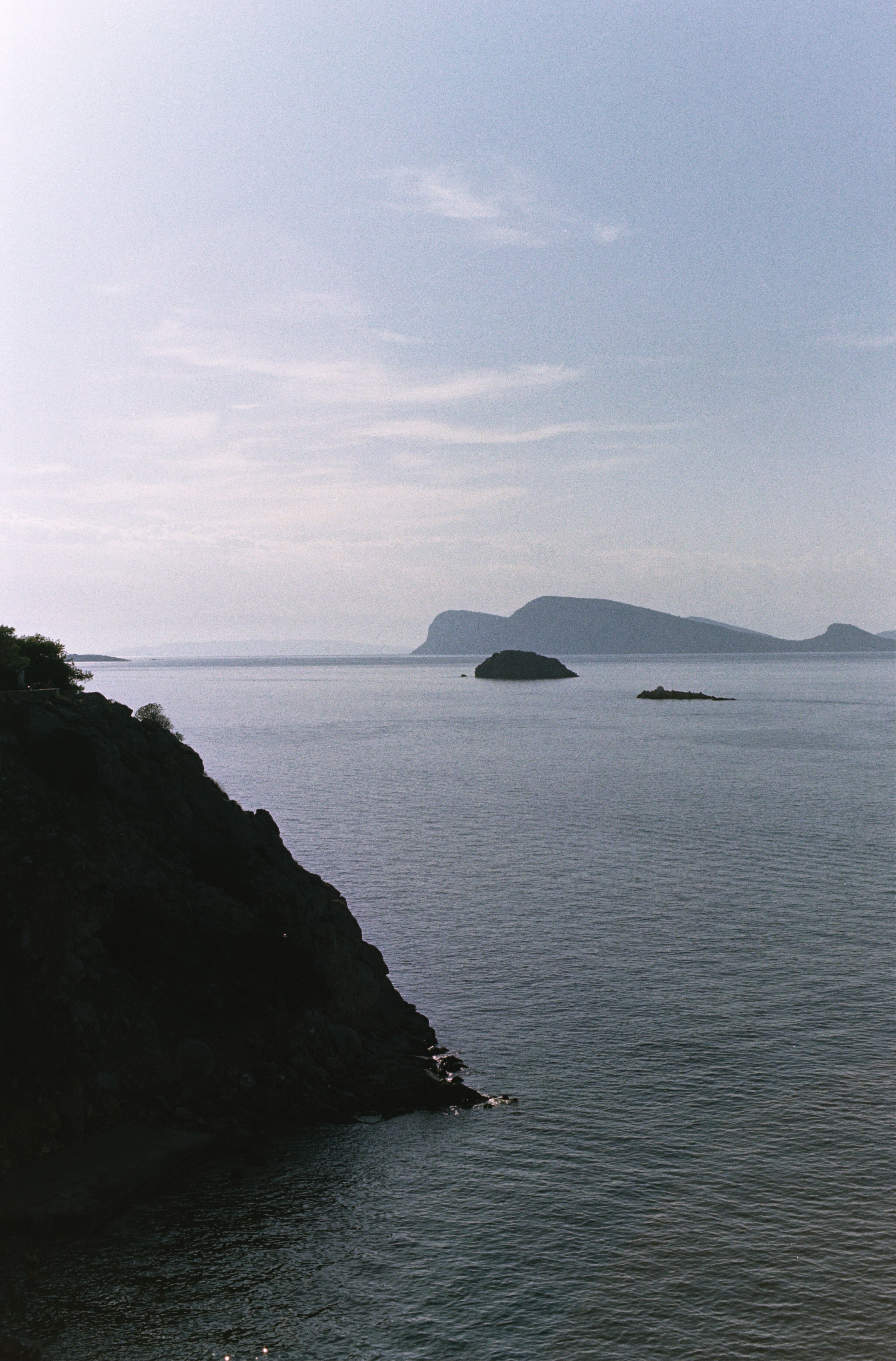
Aegean blue
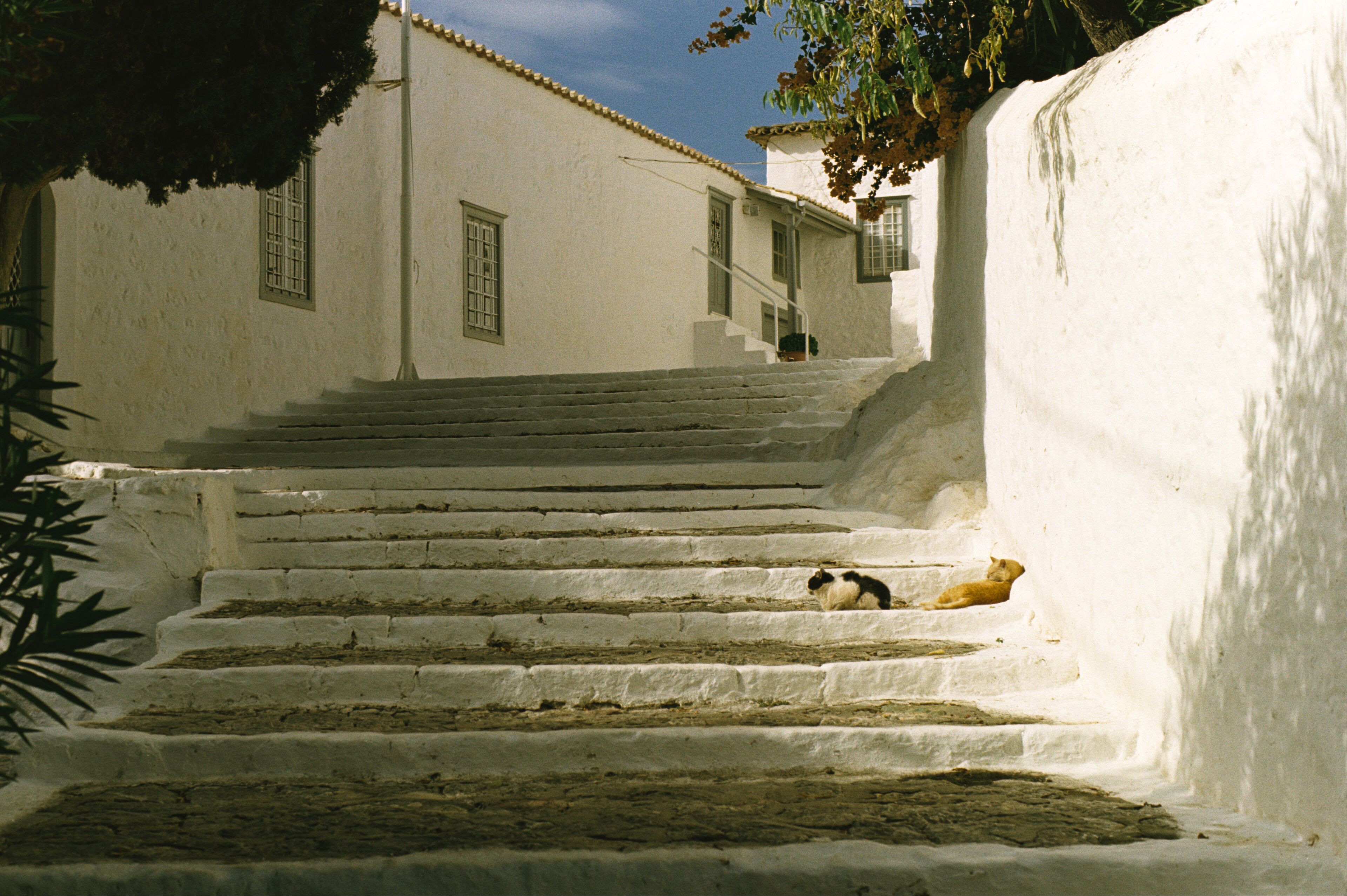
Hydra local council meeting
The standout of my trip was an eight hour hike which took me away from civilisation and into the mountains that form the spine of the island. The trail started at the village and I started walking backwards through time. Whitewashed family homes gave way to houses that hadn’t been lived in for ten years. Further away these turned into decaying shells of houses and eventually just ruins of stone from Durrell’s era and beyond. Outside of the town the land turns very steep and into rough grassy plots with small groups of animals. Stone walls and stock buildings are decorated with the universal symbol of rusted barbed wire. The walking path is unreasonably well made. Switchbacks ensure the gradient isn’t too steep and it’s obviously maintained in contrast to the ruins of old buildings dotted along it. One hour of climbing and avoiding donkey shit reveals why; it’s used to bring fish, weapons, and bitcoin mining FPGAs up to the the Prophet Elias Monastery. The monastery was established in 1813 and from I can make out is still actively lived in. It has an eternal view over the north coast of Hydra and beyond.
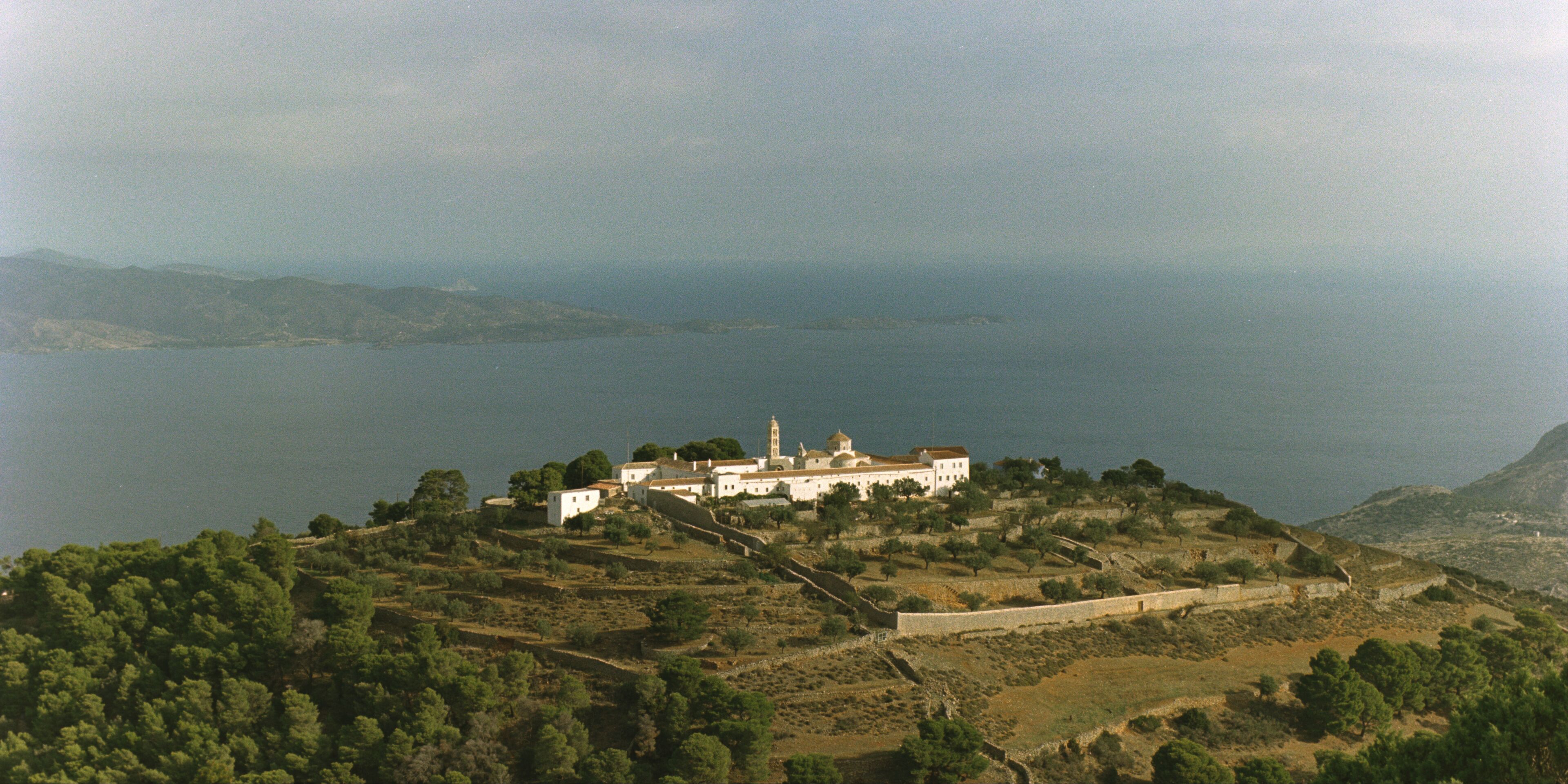
Prophet Elias Monastery from above, on Mt Eros
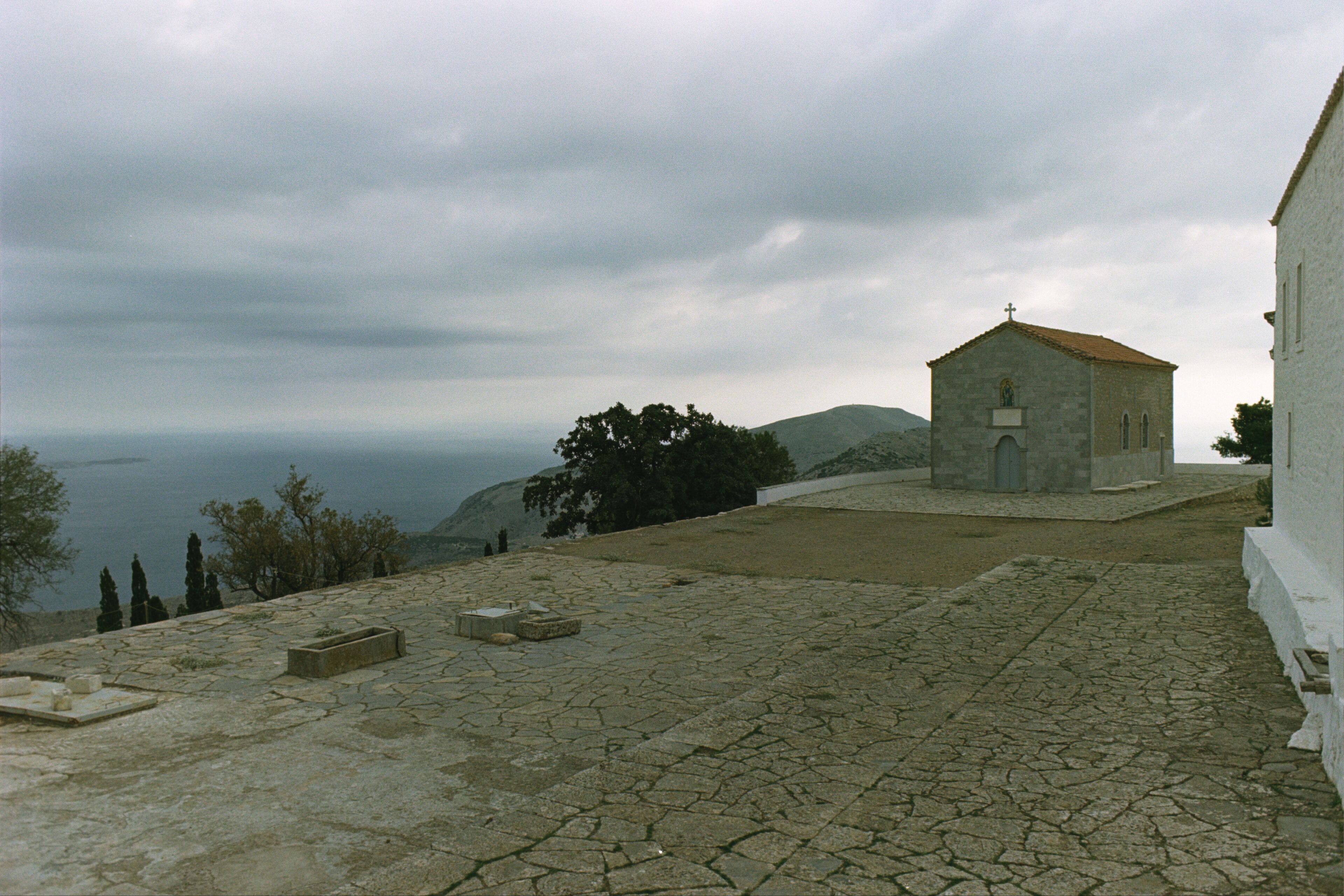
Prophet Elias Monastery
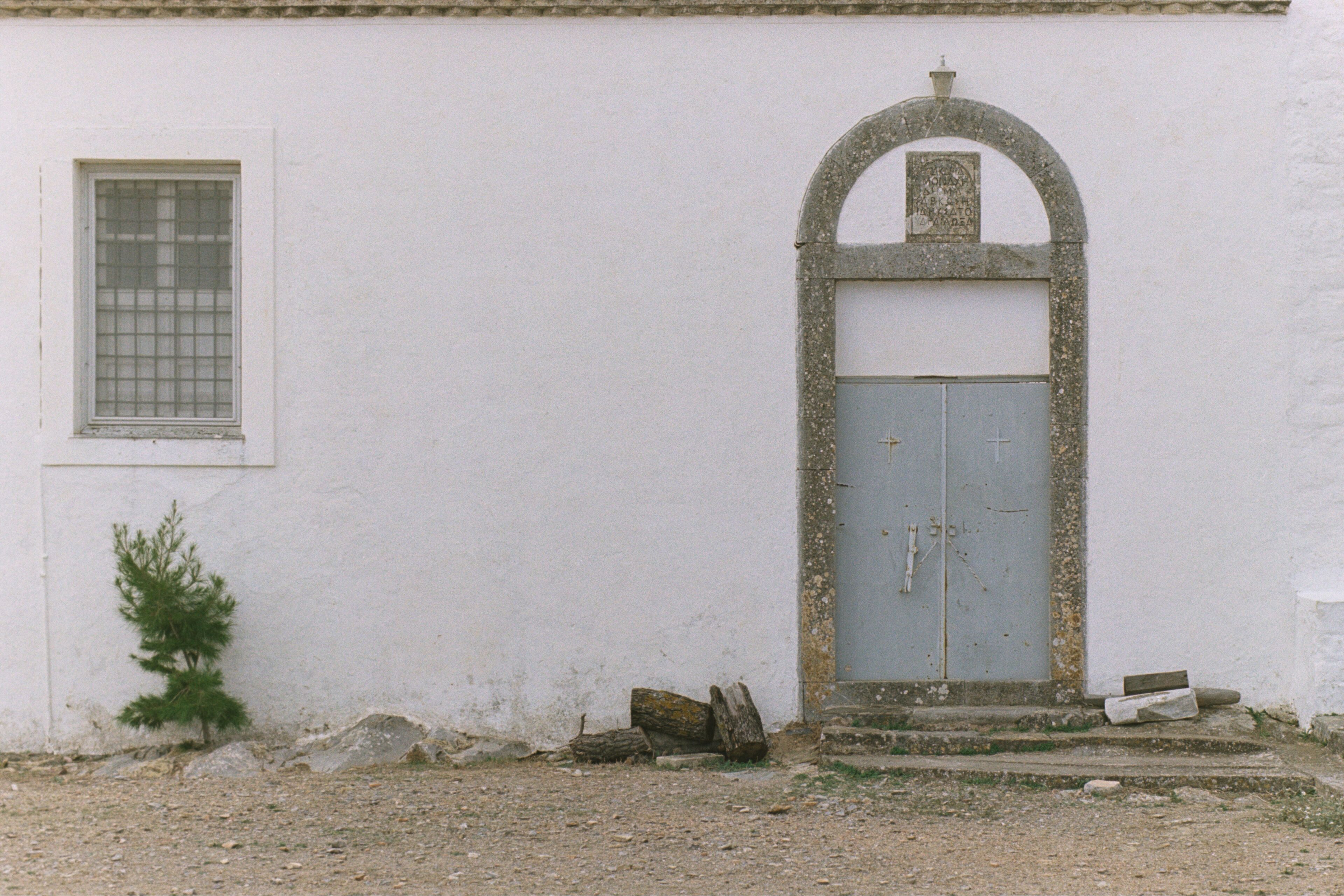
Prophet Elias Monastery
In true monastic style I didn’t see another person. The feeling of blissful isolation expressed itself in a couple of ways. There’s isolation in the personal sense, where there were no other souls around and the air held silence. My boots crunched their way around the yard and I was relieved when no apparitions in black robes and dangling silver crucifixes appeared. There was also geographic isolation which I think I captured in my photography. North of the monastery is the panoramic view across the gulf to mainland Greece. Although visible, everything feels so far away. The southern side of the monastery is shielded by mountains, hiding whatever an optimist would hope to see there. On particularly doomful days when the neighbours in my Melbourne Hollywood Squares apartment are banging about I get thoughts of leaving the city and moving out to a quiet house in the country. The monastery did have blissful isolation, but there was an undercurrent of coldness reflected by the overcast skies which made me rethink … everything.
South of the monastery is the highest peak of the island, Mt Eros. I assumed it had the name before the monks showed up, and is what lead them to build a convent just five minutes walk from the monastery. A fine decision, as it’s a very isolated area and there are plenty of secluded spots in the nearby forest where one can see the flowers bloom.
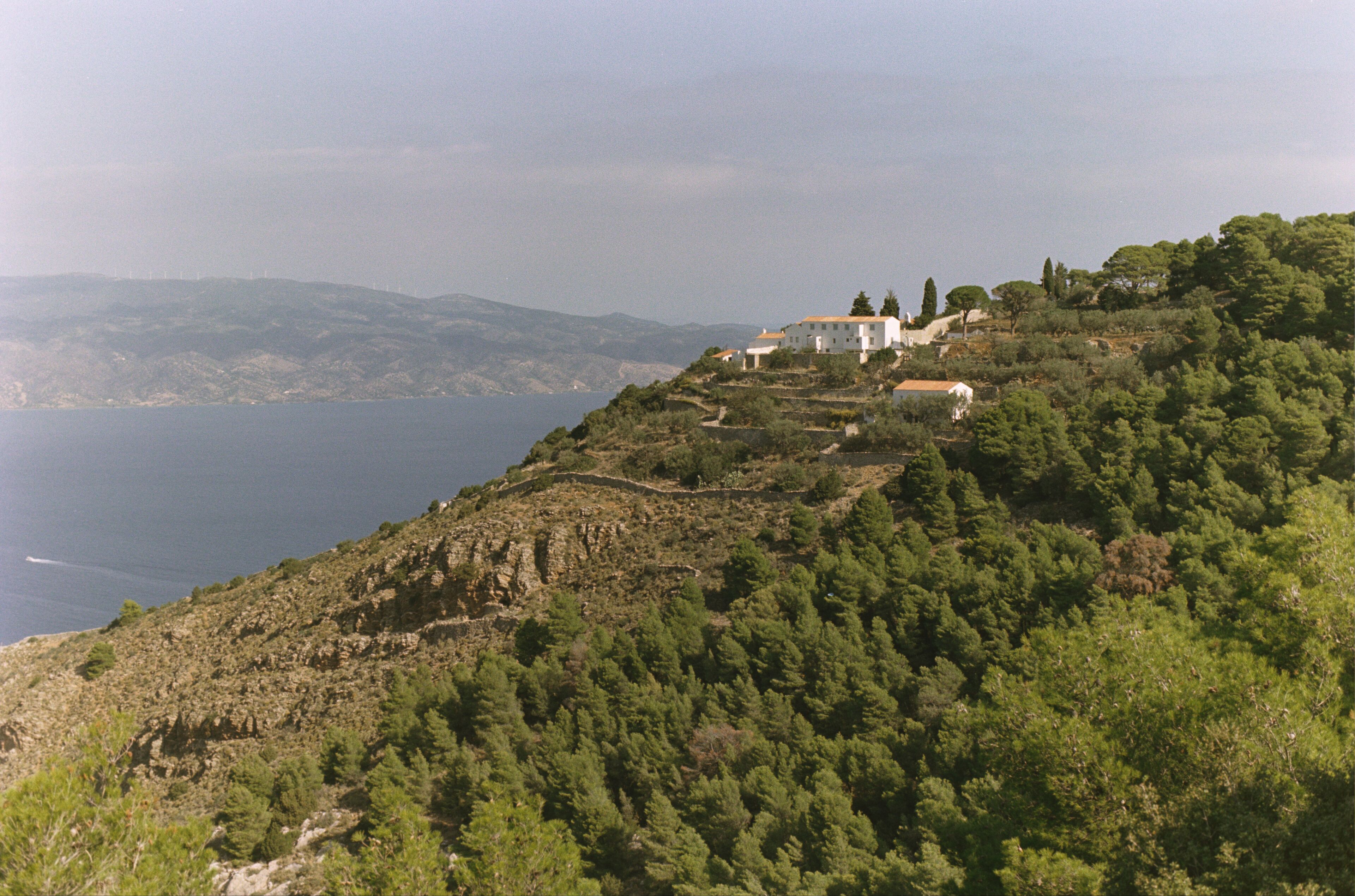
Saint Eupraxia Holy Convent
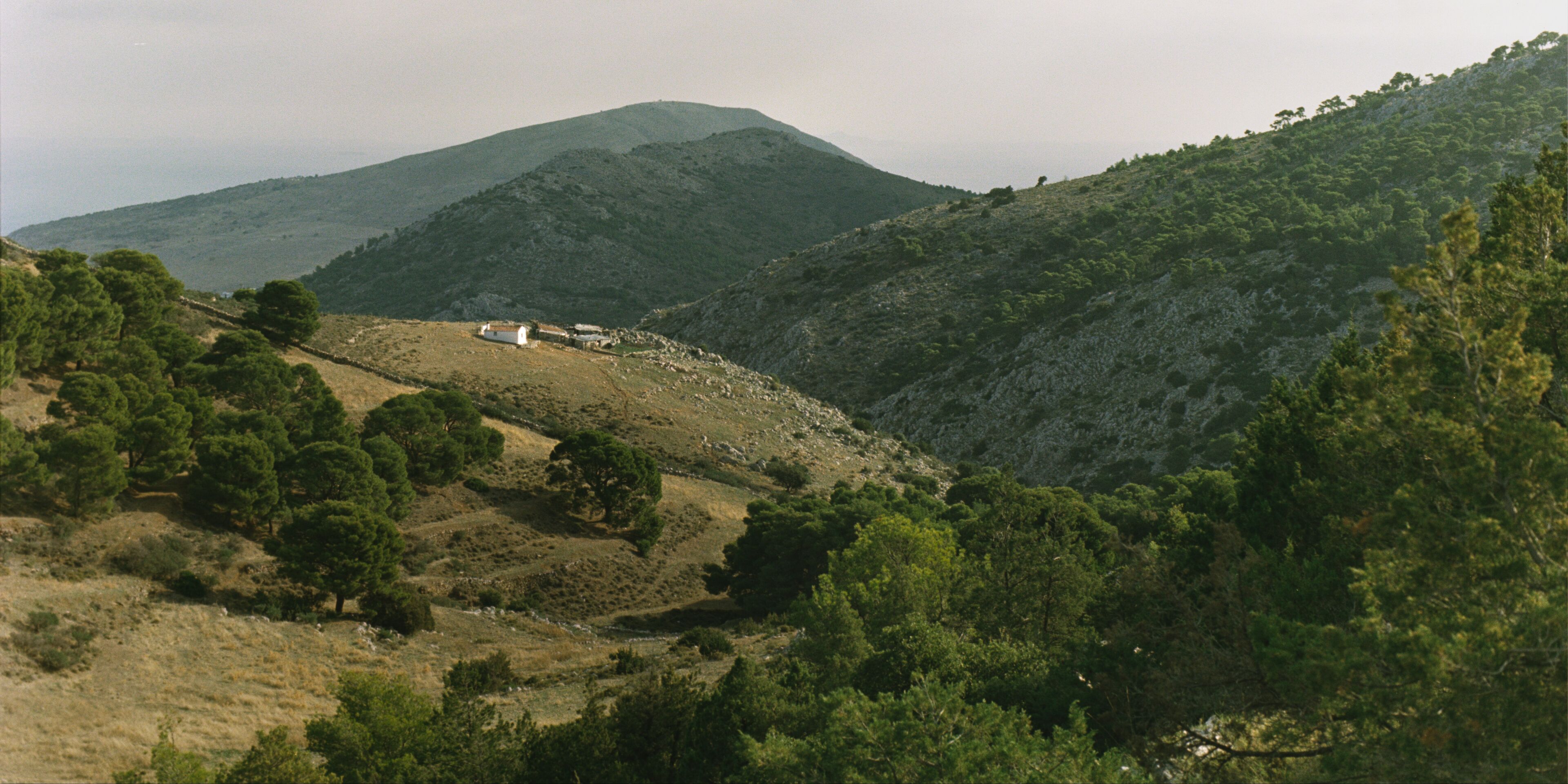
Monastery farm
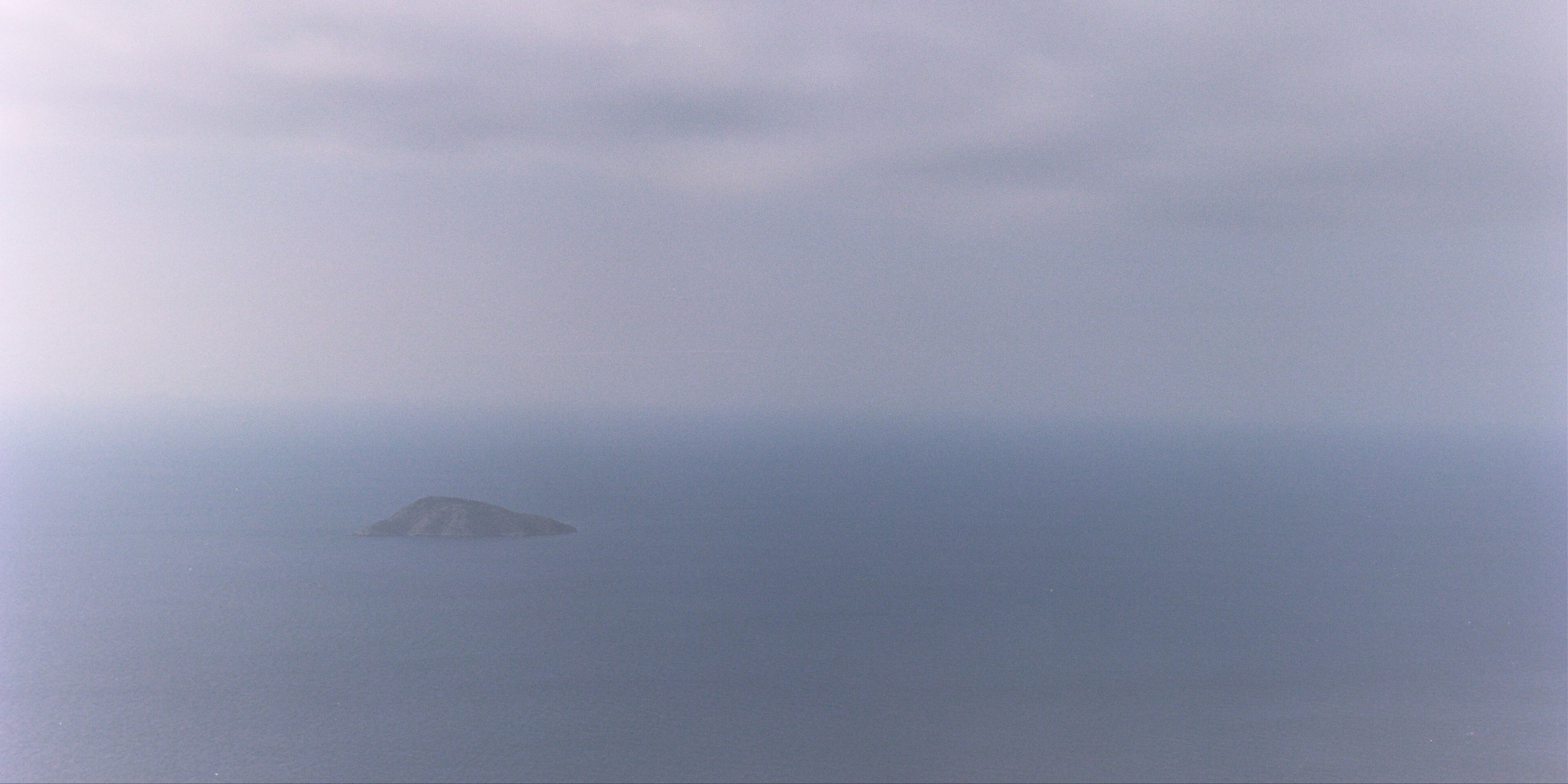
From the hazy summit of Mt Eros
When shooting colour film I get the occasional frame where the colours and contrast seems to exaggerate reality and take on a more painted or drawn look. I think it’s to do with the lenses of the 1970s when lens design and the coatings weren’t as optimised as they are today. Usually I get these in higher contrast situations, but the shot of the island above has the same look to it. The composition shouldn’t work – the horizon line is near the middle of the frame and there’s nothing to balance the island. Yet the colours and contrast make it work – the lack of contrast makes you first try and understand what it’s a photograph of, you then discover textures in the sea and sky, and the shades of blue and gray are intertwined. To me, it’s part of the magic of shooting on old lenses and film. If I took the same shot on digital there would be a lot more contrast and separation in the scene. I would have reviewed the image, saw the composition was off and thrown it away, or spent hours trying to change the colour and contrast to make it look like something it wasn’t.
From the summit of Mt Eros the path tracked south west along the rocky spine of Hydra to the olive groves of Episkopi. Along the trail were the remnants of earlier times. Sun-worn stones piled a metre high formed a wall that ran along the ridge; presumably meant for stock and property at some point in times past but now an ornamental and nostalgic device. Birds flew overhead, but no people or grazing animals to see. Along the ridge were small shrines dedicated to icons of Christian prophets. These shrines housed olive oil lamps, fuel, and generations of wilted flowers – once vibrant yellows desiccated in miniature glass houses by the Aegean sun. They were of another time, and exactly the sort of melancholic historic religious symbols you read about in a book but never see. Indeed the only place I saw them was that day hike on remote trails – far away from holiday makers and hashtags. The wall and shrines were two more ingredients in the Median Greek Island image that Durrell conjured.
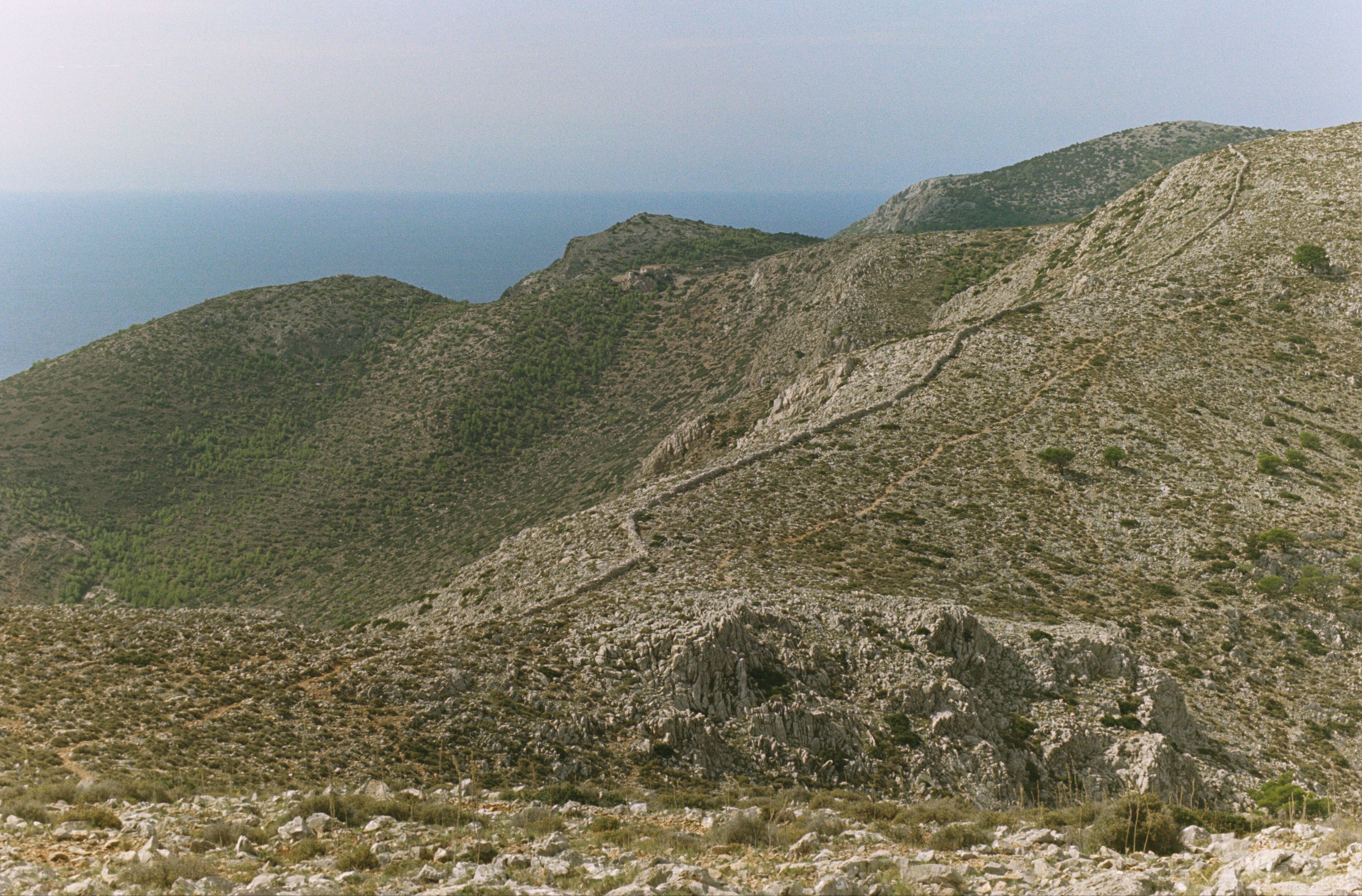
All along the ridgeline
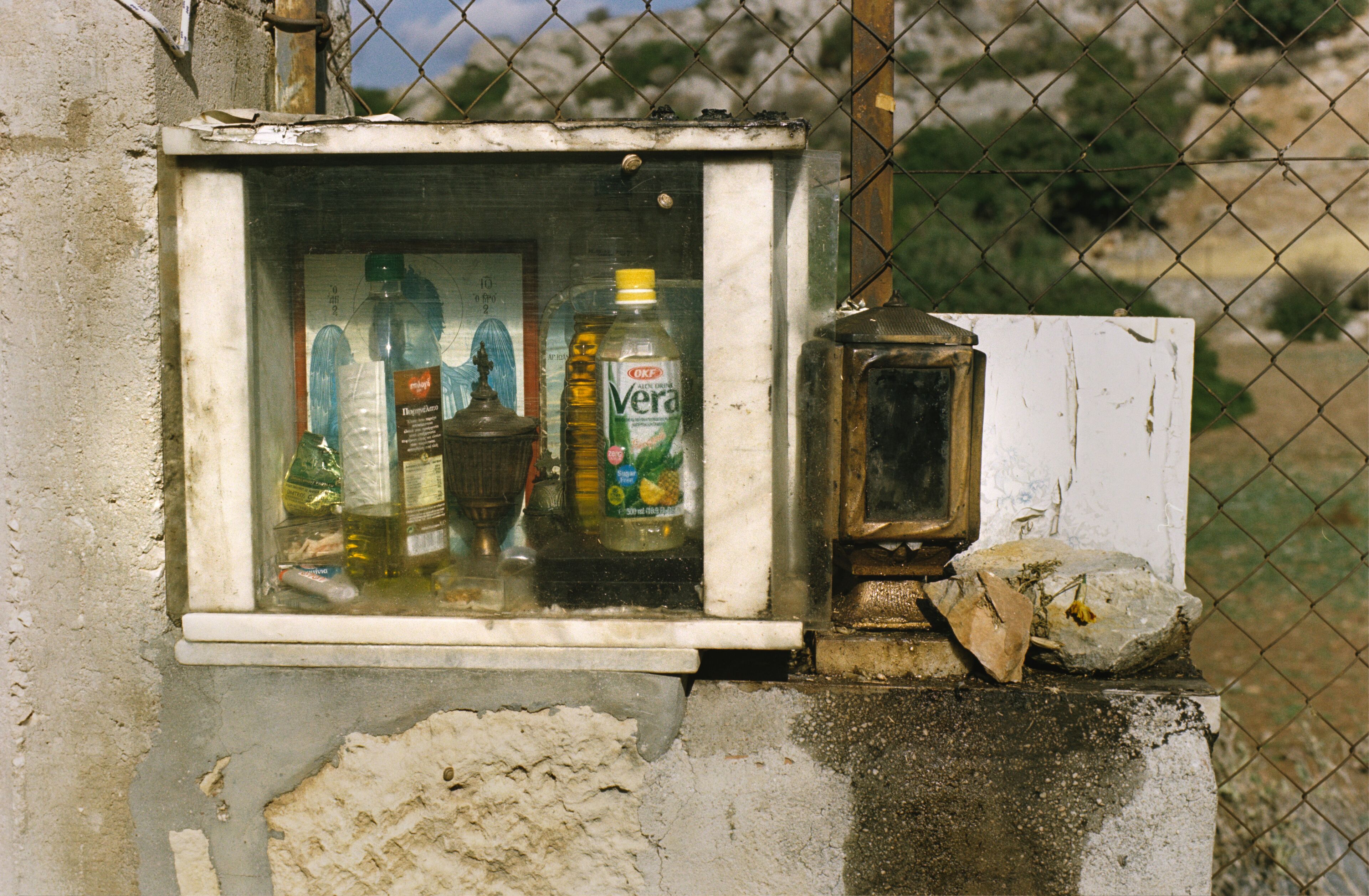
Shrine on the northern coast
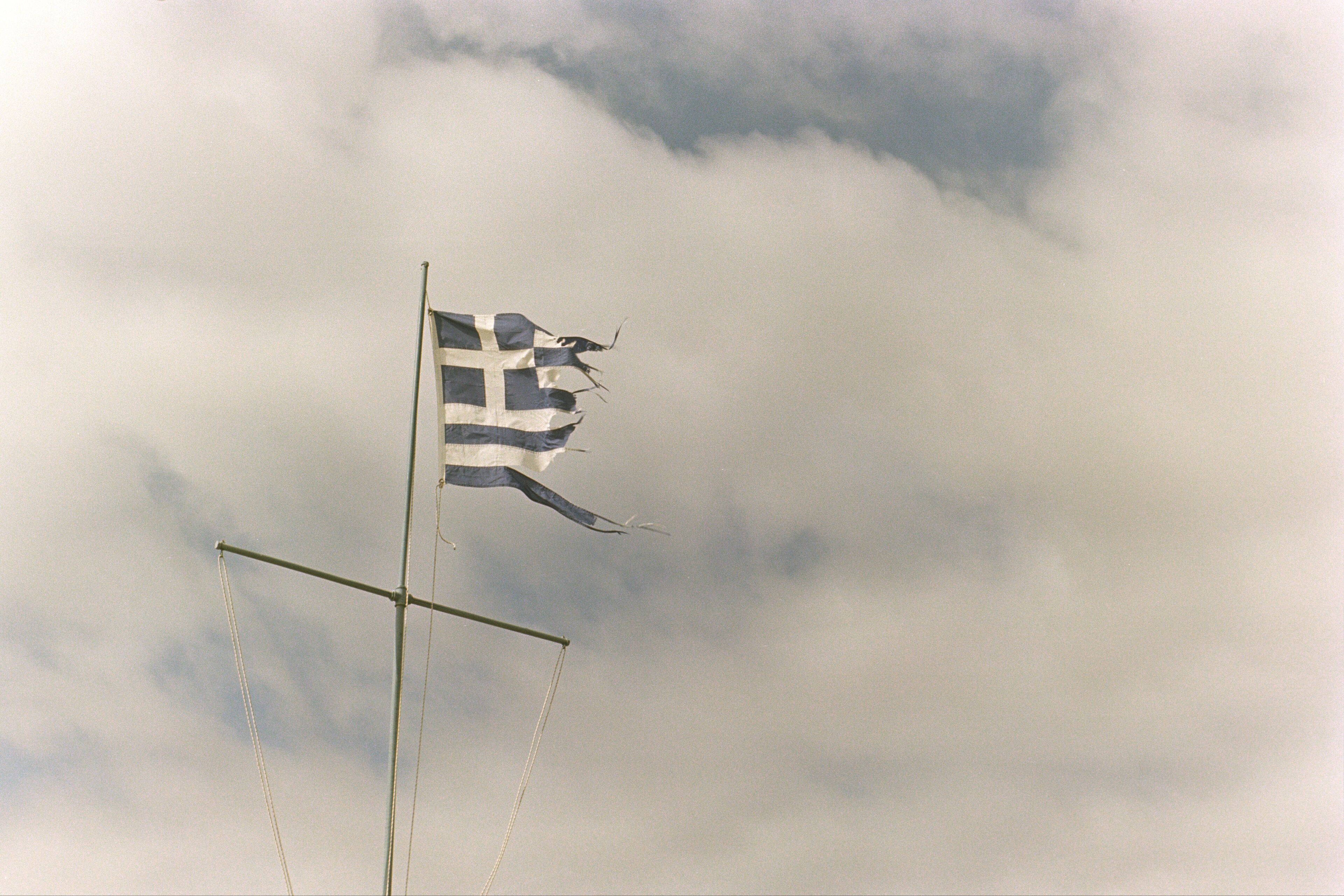
Perhaps of a time
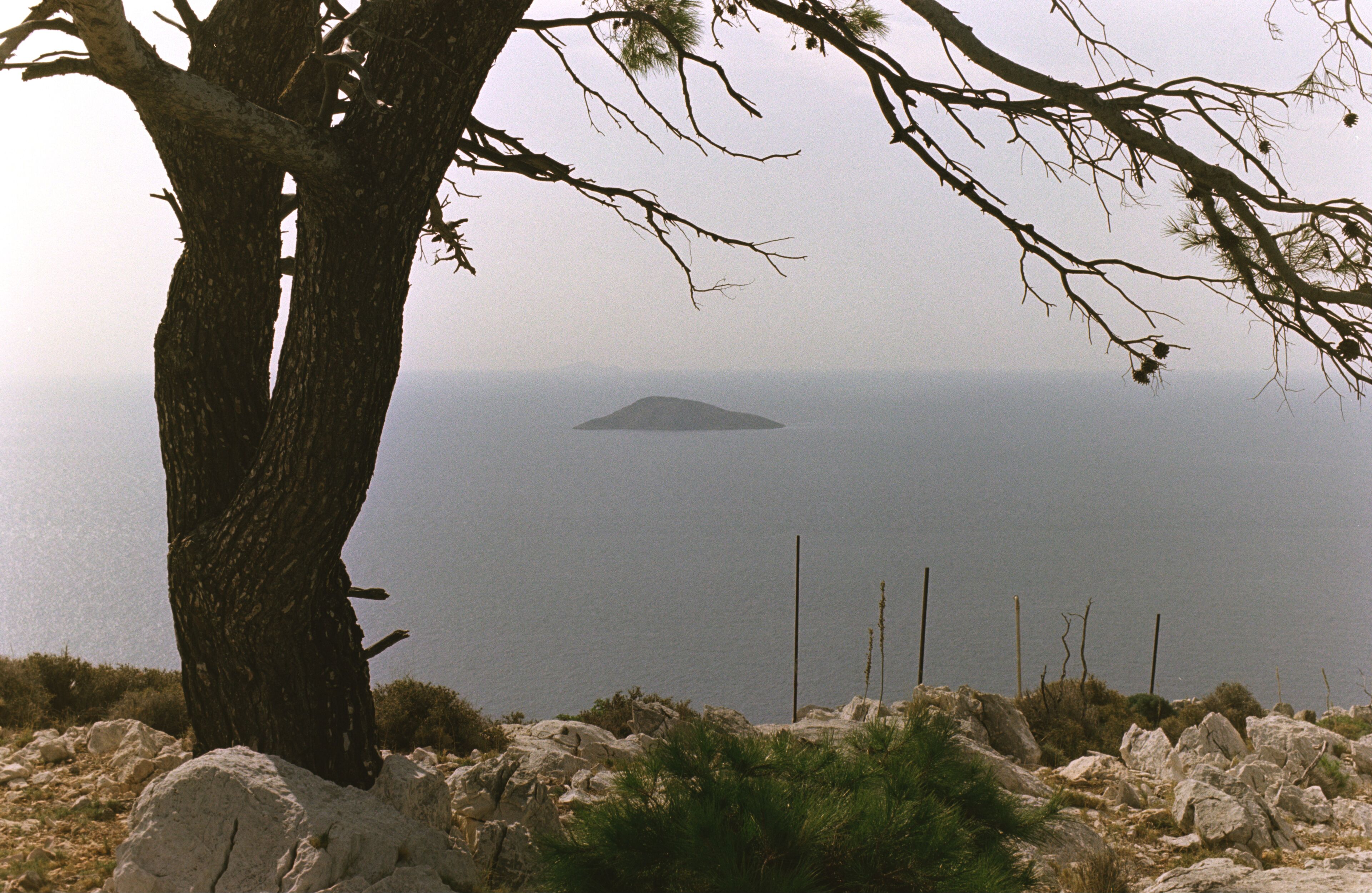
South from Hydra, Stavronisi
From Episkopi the trail worked it’s way down to the northern coast at Palamidas. This is olive country, and the dozen or so houses I saw on the hour walk down to the coast were surrounded by groves of the Greek fruit that illuminates the prophets and brings enjoyment to the rest of us. Walking down the valley removed the context of the surrounding landscape. Mountains and ocean disappeared, leaving only symbolic markers of olive trees, rusted farm equipment, and rocky peaks dotting the horizon. It was now early afternoon and the pastel cloud had burned off leaving a bright sunny autumn day. I was sitting under the shade of an olive tree changing film when it occurred to me why this place felt different. I couldn’t see the water. Hydra is intertwined with the sea – you arrive by boat, you watch the fishing ships traverse the harbour, and you eat their catch for dinner that evening. But sitting in this basin all horizons were rock and it felt very enclosed. If you were to wake up in that location with no memory, perhaps after an evening of a young Leonard Cohen’s tasting menu, you would not realise you were on an island. This was reflected in the photographs I took, with nearly every shot having an aspect of the sea.
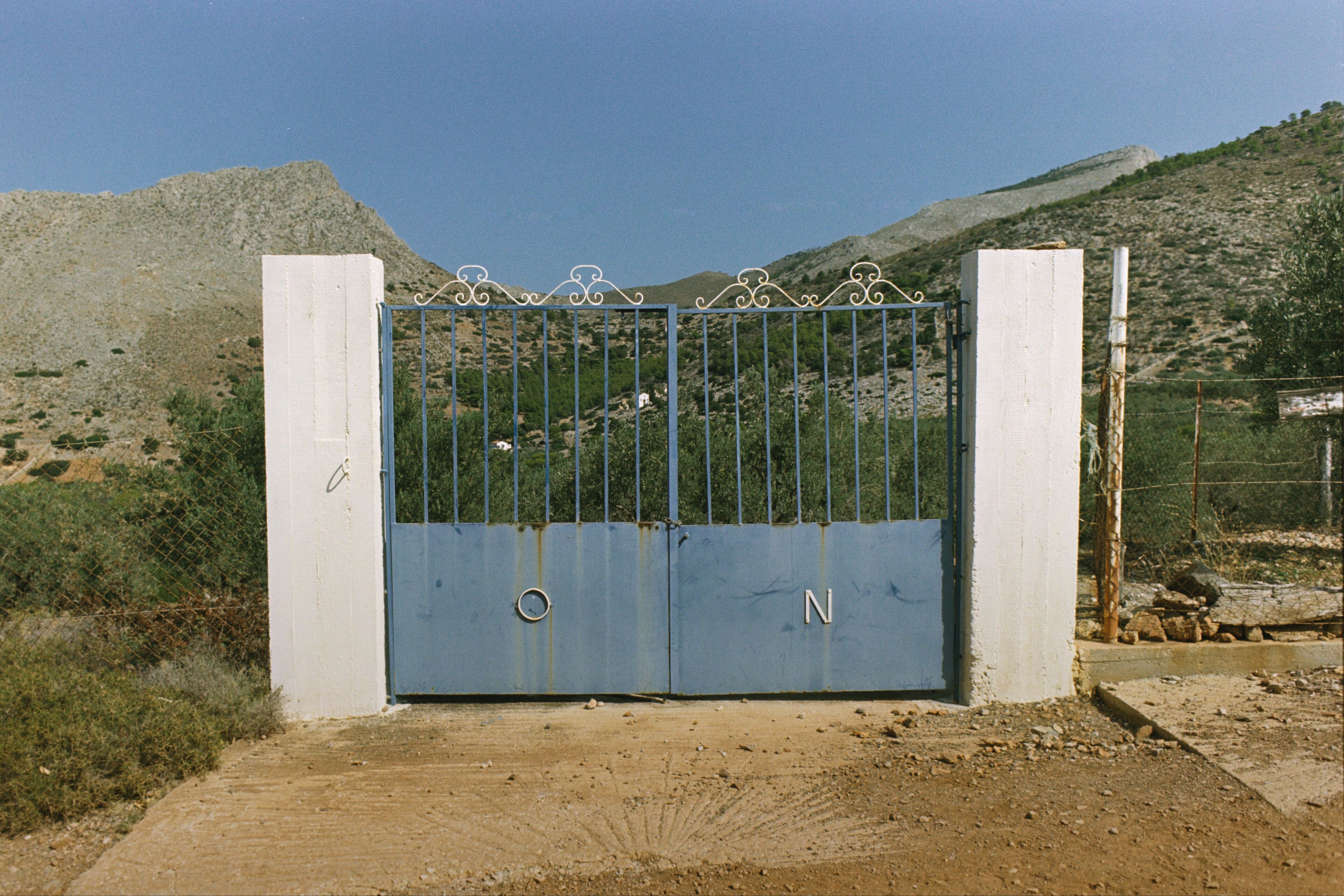
Olive farm
On reaching the coast at Palamidas the more familiar features of modernity started to reappear. Water taxis run by locals offering ten euro for a ride back to the village, Northern European nuclear familiar whose father is taking the kids out for a forced march to get them the fuck off their cell phones, and half naked Brits with hunched shoulders trudging in sandals to the sun chairs on the beach, backs the colour and shape of a boiled shrimp. The mood changed immediately, and although it was another hour a half walk to get back to the main village that quiet isolation of the interior was already lost to the more restful and relaxing coastal life. Rough paths no more, back to the paved roads of people and cats.
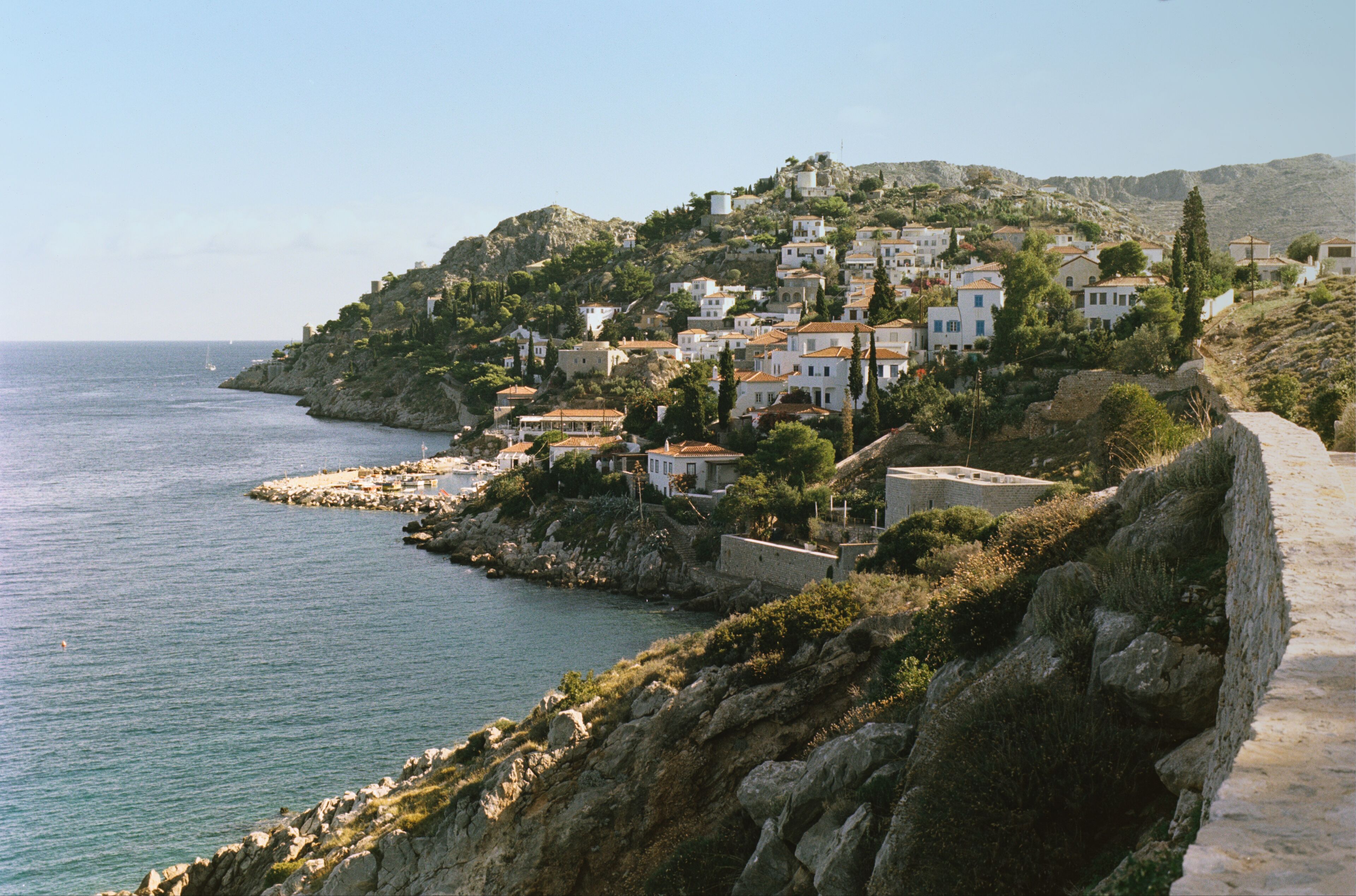
Afternoon sun
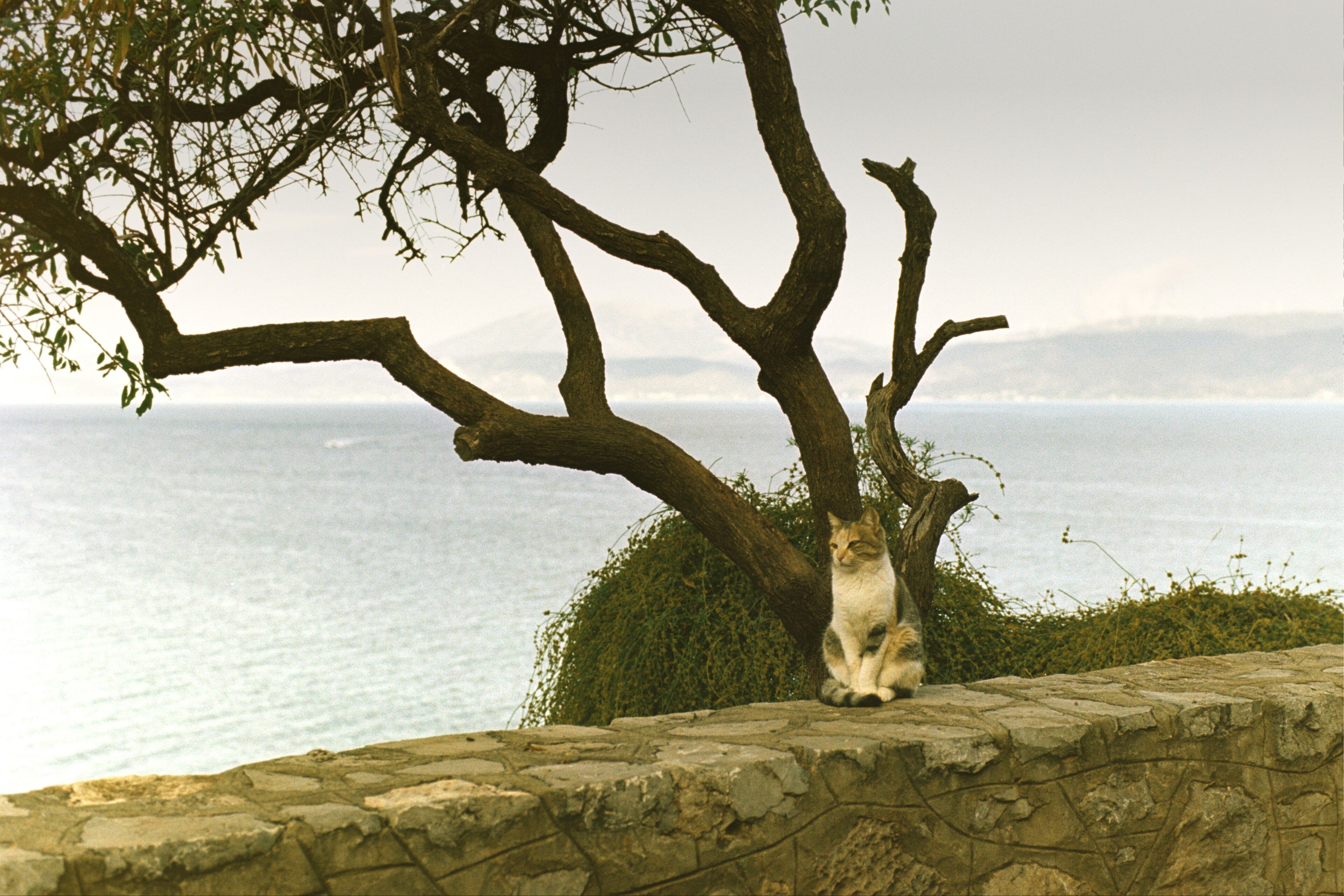
The locals
And so are the two necks of Hydra. One stretches along the coast in civility and comfort, the other climbs inland to the isolated peaks and unforgiving rocks. Both charming, quaint, and reinforcing; but with very different spirits. The mountain spirit appealed to me more – isolation, brutal geographies, and no quarter from the baking sun. Stone walls and shrines mark a path where one can traverse but not live. Both are connected to the sea and that spirit is a clear connection. From the summit of Mt Eros that spirit was so present that it felt as if I could throw a stone down the cliff and it would land in the sea. To conclude: a quote from Durrell-contemporary Henry Miller from The Colossus of Maroussi and one of my favourite photographs from my time on Hydra.
Hydra is almost a bare rock of an island and its population, made up almost exclusively of seamen, is rapidly dwindling. The town, which clusters about the harbour in the form of an amphitheatre, is immaculate. There are only two colours, blue and white, and the white is whitewashed every day, down to the cobblestones in the street. The houses are even more cubistically arranged than at Poros. Aesthetically it is perfect, the very epitome of that flawless anarchy which supersedes, because it includes and goes beyond, all the formal arrangements of the imagination. This purity, this wild and naked perfection of Hydra, is in great part due to the spirit of the men who once dominated the island. For centuries the men of Hydra were bold, buccaneering spirits: the island produced nothing but heroes and emancipators. The least of them was an admiral at heart, if not in fact.
